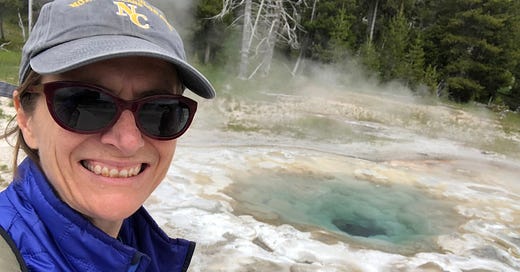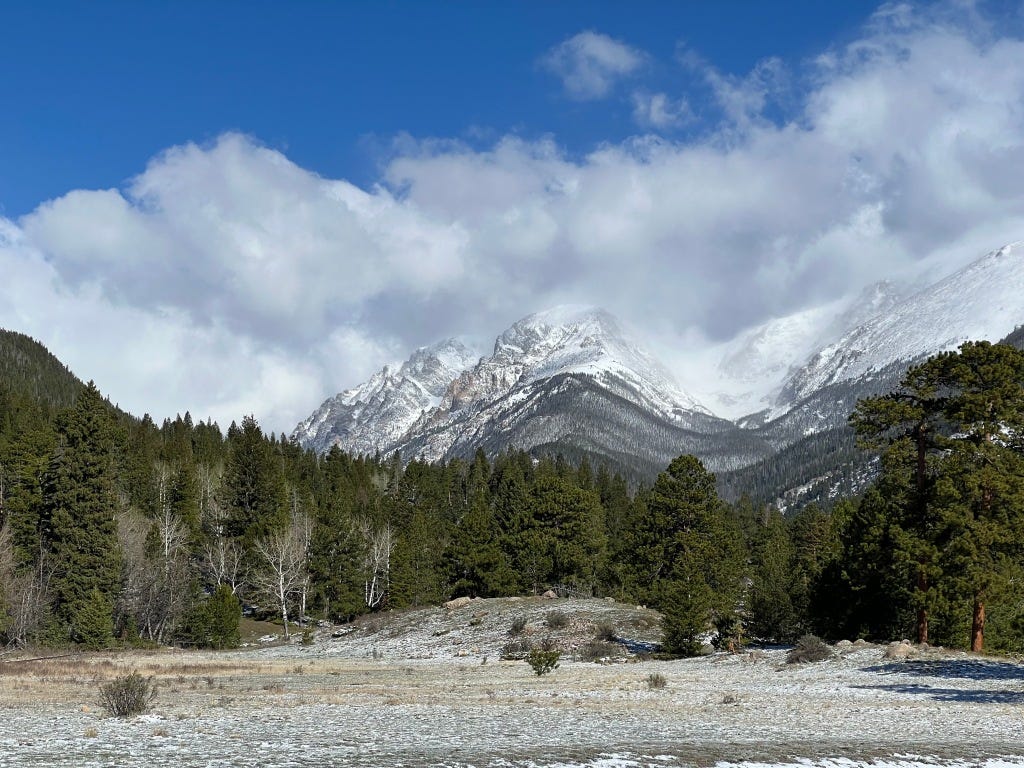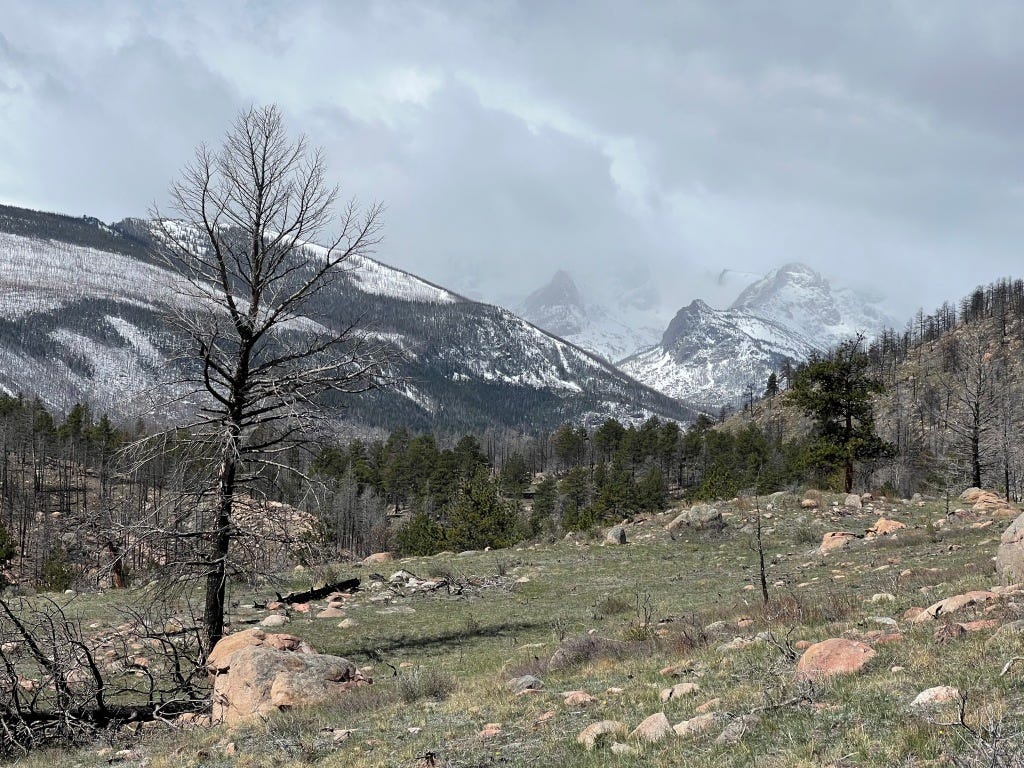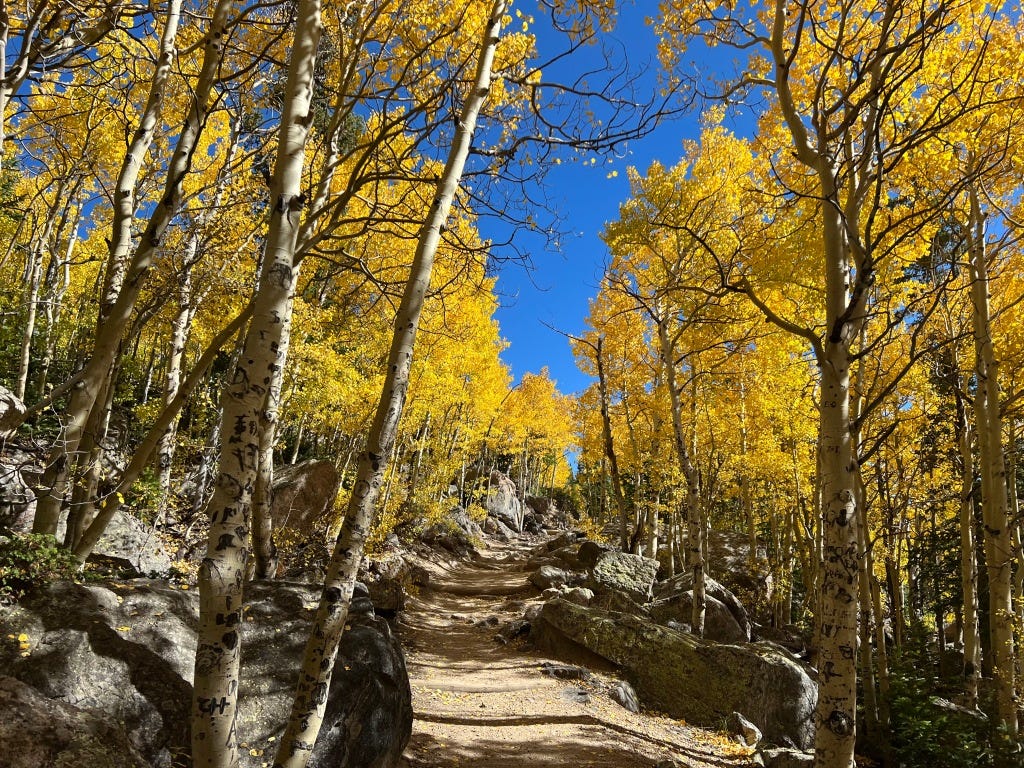Some of my first memories involve riding on my Dad's shoulders as we hiked past stinky geysers that shot mist and clouds high above our heads. I also remember staring into the abyss of a yellow-walled canyon, while water foamed and gurgled nearby, then raced over the rim. At night we had the thrill of sleeping in a log cabin with bunk beds - but Mom said I was too small to sleep in the top bunk. I was almost three years old the first time I visited Yellowstone National Park, on a road trip with my parents from California to visit my grandmother in Ohio.
We also took a helicopter ride over the Badlands (which were several years away from becoming a national park at that point). I remember wearing headphones that pinched my head as we swooped over a landscape that, to me, looked like a layered ice cream sundae.
These exceptional places left an imprint of the natural world on my mind. Maybe that's how I wound up becoming an earth scientist. But also, what stands out to me are the memories of my parents in these places - Dad holding his nose at the stinky geyser, and Mom gripping my hand at the overlook of a precipitous drop-off. These experiences of the natural world with my parents shaped my life - they shaped my own interactions with the world.
National parks have always been a part of my life, in the US and on trips abroad. Growing up in California, we made an annual pilgrimage to Yosemite for hikes along the base of towering cliffs, over boulders and across streams. Before I moved to Colorado I did the 18-mile roundtrip hike up to the top of Half Dome. I was terrified scaling the exposed shoulder of the dome with hundreds of other people gripping the steel cable that had been drilled into the rock for support. I regretted the decision to do it at the time, but I'm so glad, 20 years later, to say that I pushed myself to the top of the dome.
Now I live 90 minutes from the entrance to Rocky Mountain National Park (RMNP), and I've had the opportunity to watch the park evolve over the past two decades. There are large swaths of pine trees shading mountainsides that look like burnt red embers, thanks to the pine bark beetle. Perennial snowfields along Trail Ridge Road were once the place for summertime snowball fights, but those snow patches are now so much smaller. They are often covered with red algae in the summer (called 'watermelon snow', happens more frequently in a warmer world). This reduces the reflectivity up to 20%, causing these snow patches to shrink more quickly.
But the biggest changes sometimes happen quickly. In October 2020, the East Troublesome and Cameron Peak fires burned through 29,000 acres, or about 9% of the park. The smoke from the fires draped over northeastern Colorado in a dark, grey curtain that dropped crispy pine needles in my backyard.
I probably spent more time in Rocky Mountain Park in 2020 than in any other summer since I've lived here. In the days of social distancing, take-out groceries and restaurant orders, and general uncertainty about whether or not our lives could ever return to normal, the park offered weekly 'mini-vacations' where I could forget what was happening to the world. So it was a shock to see sections of the park that I had hiked that summer go up in flames that fall.
Hikes in the lower part of the park now ramble through burnt forest and across make-shift fire roads. We hiked through Upper Beaver Meadows last week, where firefighters were able to hold the line against the fire that could have easily advanced into the RMNP gateway town of Estes Park. In this part of the park, the fire did not burn as hot. There is new growth, and in another six weeks, there will be wildflowers. I have heard that the park west of the Continental Divide is a wasteland, but haven't yet seen it for myself.
Climate change and overcrowding have long posed threats to our parks. It's been said that our parks are 'loved to death' by the people who visit them - not just Americans, but people from around the world. Our national parks serve to preserve our cultural and natural heritage. They are laboratories for better understanding the impacts of climate change on ecosystems and landscapes. They can be a refuge for a people who have lost connection to the natural world in the daily digital grind.
I know that many of my fellow Americans take pride in our national parks, but they now face much greater threats than climate change and overcrowding. Adapting to climate change and managing hordes of tourists requires resources, and the parks (which are almost always under-resourced) are now poised to lose most of their funding (Congress appropriates about $3 billion a year for the parks. The parks also receive millions in funding each year, indirectly, through grants. In return, the parks contribute about $55 billion to the US economy). The current US governmental administration also aims to open up these and other public lands for mining, oil drilling, logging and other forms of development. Basically, it's a move toward privatizing our national parks (and pretty much everything else).
There seems to be this myth that, somehow, privatization serves the public good. So, criticism against moving to private operations that involve natural resources extraction is somehow 'un-American' - and, in that case, unpatriotic. This is a myth that has evolved over the course of my lifetime - there's even a book written about it. I deeply resent this. I'm tired of being called 'unpatriotic' because I believe in protecting - in conserving - our environment, our natural resources, and our public lands from exploitation. Protecting our public lands is an act of deep patriotism, and exercising our First Amendment rights to do so is at the heart of what it means to be an American.
Please do what you can to protect our parks. Call your congressional representatives and senators. (Check out the National Park Conservation Organization advocacy page). Donate if you can. Tread lightly if you visit the parks. It may not feel like much, but it is our collective effort that will make a difference and give future generations a chance to better understand their connection to our natural world through the parks.
For more on the threats to public lands, and what you can do, see this Substack: More Than Just Parks.
Also, FYI, the 'One Big Beautiful' bill that just (today) passed the House congressional vote would do the following (among many, many other things, listed so succinctly by Alt National Park Service):
Repeal the Clean Air Act that limits emission (Sec. 42108)
End EPA authority to enforce vehicle emissions (Sec. 42301)
Rescind funds from national parks, conservation, and climate programs (Secs. 80307-80309)
Rescind funds from the National Park Service and Bureau of Land Management as well as block federal land conservation plans (Sec. 80301-80309)
End environmental data programs (Sec. 80151-80152)
All of these things are aligned with Project 2025 which aims to end environmental oversight and ramp up fossil fuel production. This Bill (link takes you to White House propaganda page) is Project 2025 enacted.









Thank you for your work, Cindy, and mostly for your love. The earth needs an advocate like you ❤️